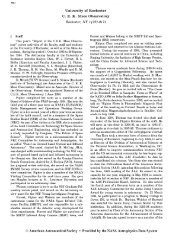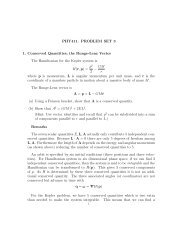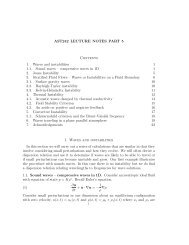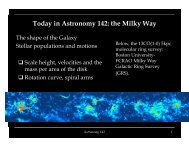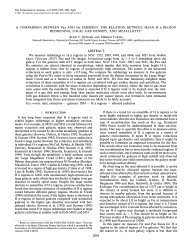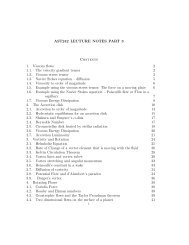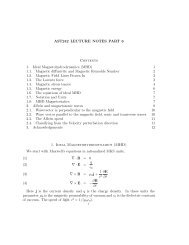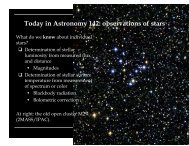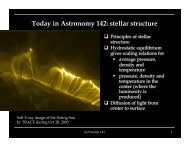Today in Astronomy 142 - Astro Pas Rochester
Today in Astronomy 142 - Astro Pas Rochester
Today in Astronomy 142 - Astro Pas Rochester
You also want an ePaper? Increase the reach of your titles
YUMPU automatically turns print PDFs into web optimized ePapers that Google loves.
<strong>Today</strong> <strong>in</strong> <strong><strong>Astro</strong>nomy</strong> <strong>142</strong>More on the Sun as a typicalstar:! Radiative transport andoptical depth! The spectrum of thesurface (atmosphere) ofthe Sun! The structure of the sun’souter layers: convection,rotation, magnetism andsunspots! Solar energyMulticolor ultraviolet image of the Sun, show<strong>in</strong>gseveral sunspot-rich active regions (TRACE/NASA).<strong><strong>Astro</strong>nomy</strong> <strong>142</strong> 1
The solar spectrumBy and large, the spectrum of theSun resembles closely a blackbody.From the total energy flux atEarth (solar constant):we get the Sun’s lum<strong>in</strong>osity:Sett<strong>in</strong>g solar lum<strong>in</strong>osity equal to blackbody power givesSun’s effective temperature:<strong><strong>Astro</strong>nomy</strong> <strong>142</strong> 2
In detail:absorption l<strong>in</strong>esare also seen <strong>in</strong>the solarspectrum; theymatch up withmany knowntransitions ofatoms, ions andmolecules. (SeeLab #2.)The solar spectrum (cont<strong>in</strong>ued)Figure: the ultimate high-resolution spectrum of the Sun (Nigel Sharp, fromdata by Bob Kurucz et al. ( NOAO/NSO/Kitt Peak FTS/AURA/NSF)<strong><strong>Astro</strong>nomy</strong> <strong>142</strong> 3
Formation of absorption l<strong>in</strong>es <strong>in</strong> the solaratmosphereFigure: Chaisson andMcMillan, <strong><strong>Astro</strong>nomy</strong> <strong>Today</strong><strong><strong>Astro</strong>nomy</strong> <strong>142</strong> 4
Radiation transportkeep<strong>in</strong>g track of energy <strong>in</strong> radiation<strong><strong>Astro</strong>nomy</strong> <strong>142</strong> 5
Radiative transportoptical depth dI = Id⌧dId⌧ =II(⌧) =Ie ⌧light miss<strong>in</strong>g<strong>in</strong>tegrateτ is unit lessopticalZdepth⌧ = apple⇢dsκopacity units g -1 cm 2κρ units cm -1amount of light go<strong>in</strong>gmiss<strong>in</strong>g per unitlength<strong><strong>Astro</strong>nomy</strong> <strong>142</strong> 6
Mean free pathκopacity units g -1 cm 2κρ units cm -1amount of light go<strong>in</strong>g miss<strong>in</strong>g per unit lengthabsorption per unit lengthκρ = n σn particles per unit volume (cm -3 )σ cross section (cm 2 )l = (n σ) -1 = (κρ) -1 (cm) how far a photon goes before gett<strong>in</strong>g absorbedthe mean free path<strong><strong>Astro</strong>nomy</strong> <strong>142</strong> 7
Relation between ext<strong>in</strong>ction and optical depth<strong><strong>Astro</strong>nomy</strong> <strong>142</strong> 8
Opacity depends onwavelength because of atomicand molecular transitionsIf the opacity is higher thenwe see only <strong>in</strong> the top layerswhere it is cooler.When it is cooler the surfacebrightness is lower<strong><strong>Astro</strong>nomy</strong> <strong>142</strong> 9
opacity and photosphered⌧ = apple⇢drd⌧dr = apple⇢dPdr = ⇢gdPd⌧ = dPdroptical depth with radiushydrostatic equilibriumdrd⌧ = ⇢g ⇥ 1apple⇢ = g appleat photosphere τ=1P at photosphere =g/κPressure broaden<strong>in</strong>g of spectral l<strong>in</strong>es gives ameasurement for g<strong><strong>Astro</strong>nomy</strong> <strong>142</strong> 10
Solar “granulation:” the tops of convection cellscredit:NOAOFigure: Chaisson and McMillan, <strong><strong>Astro</strong>nomy</strong> <strong>Today</strong><strong><strong>Astro</strong>nomy</strong> <strong>142</strong> 12
Simulations of convectioncredit:FrankRob<strong>in</strong>son<strong><strong>Astro</strong>nomy</strong> <strong>142</strong> 13
Us<strong>in</strong>g Adaptive Optics to look at detailVisible images fromThe 1m Swedish SolarTelescope at La Palmashow filaments nearsunspots as well as thegranulation. The darkcored filaments wereunexpected.<strong><strong>Astro</strong>nomy</strong> <strong>142</strong> 14
More detail on Sun spots<strong><strong>Astro</strong>nomy</strong> <strong>142</strong> 15
Further out: the corona and chromosphereCorona: observed tobe well over 1000000K.Theory of corona:heated by acousticnoise from boil<strong>in</strong>gtop of convectionzone; diffuse enoughthat it can’t cool verywell, so it reachesvery hightemperatures.Figure: Chaisson andMcMillan, <strong><strong>Astro</strong>nomy</strong> <strong>Today</strong><strong><strong>Astro</strong>nomy</strong> <strong>142</strong> 16
Solar corona and atmosphere X-ray composite(NASA/SPARTAN)<strong><strong>Astro</strong>nomy</strong> <strong>142</strong> 17
Sunspots: solar magnetismFigure: Chaisson and McMillan, <strong><strong>Astro</strong>nomy</strong> <strong>Today</strong>! Sunspots appeardark becausethey’re slightlycooler than the restof the solar surface.! Zeeman effectmeasurementsshow that they arealso maxima ofmagnetic field.! Associated withother activity (e.g.prom<strong>in</strong>ences)<strong><strong>Astro</strong>nomy</strong> <strong>142</strong> 18
The multi-wavelength real-time Sun accord<strong>in</strong>g to SOHOPulled off the SOHOwebsite on Jan24/2003. This iswhat the sun lookedlike <strong>in</strong> X-rays andUV l<strong>in</strong>es, opticalcont<strong>in</strong>uum and witha magnetogram.<strong><strong>Astro</strong>nomy</strong> <strong>142</strong> 19
Sunspot progress, activity dur<strong>in</strong>g solar cycleFigure:Chaisson andMcMillan,<strong><strong>Astro</strong>nomy</strong><strong>Today</strong><strong><strong>Astro</strong>nomy</strong> <strong>142</strong> 20
The 11-year sunspot cycleThe first sunspots <strong>in</strong> a cycle form near ±30° latitude, and thelast near the equator, produc<strong>in</strong>g the “butterfly diagram.”David Hathaway, NASA/MSFC<strong><strong>Astro</strong>nomy</strong> <strong>142</strong> 21
11-year sunspot cycle, for the last 400 yearsFigure: Chaisson and McMillan, <strong><strong>Astro</strong>nomy</strong> <strong>Today</strong><strong><strong>Astro</strong>nomy</strong> <strong>142</strong> 22
Sunspot formation and cycle: <strong>in</strong>teraction ofmagnetism and differential rotationThe Sun rotates, but not as a solid body; this differentialrotation wraps and distorts an <strong>in</strong>itially “poloidal” solarmagnetic field.! Occasionally, the field l<strong>in</strong>es burst out of the surface andloop through the lower atmosphere, thereby creat<strong>in</strong>g asunspot pair. The underly<strong>in</strong>g pattern of the solar fieldl<strong>in</strong>es expla<strong>in</strong>s the observed pattern of sunspot polarities.! If the loop happens to occur on the limb of the Sun and isseen aga<strong>in</strong>st dark space, a prom<strong>in</strong>ence is visible.! The twist<strong>in</strong>g and wrapp<strong>in</strong>g of the field l<strong>in</strong>es eventuallyresults <strong>in</strong> the production of a poloidal field aga<strong>in</strong>, but withnorth and south switched. Then the process repeats.! 22 years between identical field configurations, 11 yearsbetween sunspot-number maxima.<strong><strong>Astro</strong>nomy</strong> <strong>142</strong> 23
Sunspot formation and cycle: <strong>in</strong>teraction ofmagnetism and differential rotationFigure: Chaisson and McMillan, <strong><strong>Astro</strong>nomy</strong> <strong>Today</strong><strong><strong>Astro</strong>nomy</strong> <strong>142</strong> 24
Energy and the sun! Hydrostatic equilibrium and ideal-gas behavior ensurethat the center of the Sun is very hot, and energy (<strong>in</strong> theform of light) is radiated from the center.! The high opacity of the Sun to light determ<strong>in</strong>es the rate atwhich the energy leaks out. As we have seen, it takes along time for photons to diffuse from center to surface.! This cannot go on forever, without the Sun cool<strong>in</strong>g down,or replacement for the energy that leaks away.! We know that the solar system is about 4.5x10 9 years old(from many radioisotope abundance measurements onmeteorites), and that life has existed here for at least 3x10 9years. Thus the Sun must have had close to its presentlum<strong>in</strong>osity for billions of years.<strong><strong>Astro</strong>nomy</strong> <strong>142</strong> 25
Cool<strong>in</strong>g timescale<strong><strong>Astro</strong>nomy</strong> <strong>142</strong> 26
How long would the Sun’s present heat last?Plasma energy density at center of Sun (energy density of electron gasthere, considered aga<strong>in</strong> to be ideal):Energy density of light, which is about to leak away:We showed last lecture that it takes about t = 31000 years for a photon toleak from center to surface, so the heat lastsThus some process must be replac<strong>in</strong>g the energy that leaks away.<strong><strong>Astro</strong>nomy</strong> <strong>142</strong> 27
Energy sources for the SunChemical energy (burn<strong>in</strong>g) doesn’t work.“The Sun is noth<strong>in</strong>g but a burn<strong>in</strong>g ember:” Anaxagoras ofClazomenae, ca. 450 BC.Suppose (optimistically) that the Sun were made of anthracitecoal, with enough oxygen to burn it completely to CO 2 :5.5x10 32 gm coal, 1.45x10 33 gm O. Burn<strong>in</strong>g 1 gm of anthracitecoal to CO 2 liberates 4.3x10 11 erg. Thus the Sun’s <strong>in</strong>itialenergy reserve would beΔE =4.3x10 11 x 5.5x10 32 erg = 2.4 x 10 44 ergwhich at the Sun’s present lum<strong>in</strong>osity would last<strong><strong>Astro</strong>nomy</strong> <strong>142</strong> 28
Energy sources for the Sun (cont<strong>in</strong>ued)Collapse and liberation of gravitational potential energyalso doesn’t work (Kelv<strong>in</strong> and Helmholtz, late 19th century):However, mass energy would work, even if only 0.1% of itcould be converted to radiation:<strong><strong>Astro</strong>nomy</strong> <strong>142</strong> 29
Energy sources for the Sun (cont<strong>in</strong>ued)How could the Sun convert mass-energy to radiation?! Nuclear fusion: basically the liberation of mass energystored as potential energy of the strong nuclear<strong>in</strong>teraction.Would this work under the conditions known to prevail atthe center of the Sun?! Yes. Requires such conditions, <strong>in</strong> fact.To demonstrate these answers we need to talk a bit about thefundamental <strong>in</strong>teractions of matter.<strong><strong>Astro</strong>nomy</strong> <strong>142</strong> 30
Summary! Phenomenology of the Sun: sunspots, active regions,magnetic activity, solar cycle, solar dynamo.! Solar structure: radiative core and convection zone,photosphere, chromosphere, corona.! Solar energy problem. Only nuclear reactions provide aplausible energy source for the billion year timescale thatthe Sun has been lum<strong>in</strong>ous.! Opacity and radiative transport<strong><strong>Astro</strong>nomy</strong> <strong>142</strong> 31




